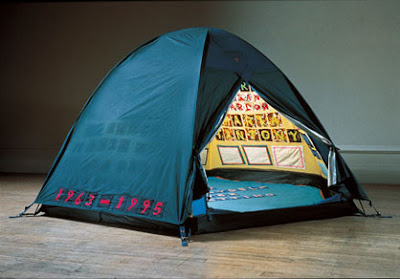INROADS: Curator's Statement
>> Tuesday, October 26, 2010 –
Brozyna,
printmaking,
Second Space,
spiritual,
Valenza
Yvonne Valenza, Jumble, from the exhibit INROADS
An ongoing project of mine (I'm heading it up, anyway) is an art exhibit space in my place of worship, Oxford Circle Mennonite Church, called Second Space Arts. The current exhibit (up until the 28th of November) is entitled INROADS, the work of Tegan Brozyna and Yvonne Valenza. Their work in this exhibit deals with both the ins and outs (inward and outward) aspects of journey...and how our individual journeys impact others, as well as our environment. What follows is the curatorial statement I wrote for the show:
Coming soon...part 3 of Wherefore Painting?
Read more...
An ongoing project of mine (I'm heading it up, anyway) is an art exhibit space in my place of worship, Oxford Circle Mennonite Church, called Second Space Arts. The current exhibit (up until the 28th of November) is entitled INROADS, the work of Tegan Brozyna and Yvonne Valenza. Their work in this exhibit deals with both the ins and outs (inward and outward) aspects of journey...and how our individual journeys impact others, as well as our environment. What follows is the curatorial statement I wrote for the show:
Curator’s Statement
Inroads: Brozyna and Valenza
Life’s a journey: we’ve all heard this so many times, it’s nearly a cliché. But like most clichés, it has its origin in dignified truth. In a Western (European/American, generally) cultural sense, this journey is implied as linear – one occurrence after another, lined up like fence-posts or hatch-marks – creating a line which does not return. In the Eastern (Asian/African; again generally) cultural concept, a journey often assumes, rather than linear, a circular progression: occurrences repeat; one’s actions influence how you are acted upon. This is related to the concept of karma: good results in good; bad often results in bad.
Looking at topography (the “lay of the land”) or cartography (maps) should then resonate with our guts – our instincts, so to speak – and visually remind us that extremes are often incorrect: the truth is often somewhere nearer the middle. The meandering lines found in Tegan Brozyna’s paintings and works on paper are a fine synthesis of the linear and the circular versions of journey. In a real sense, rather than life being a journey, life is journeying: the passive becomes active. In Brozyna’s works, we visually walk with her over hill and dale; through the streets and avenues of America, all the while enjoying the view afforded by Brozyna’s joyful re-working of the landscape, and its realignment into a more ambiguous space. Painted on “bird’s-eye view” maps, the lines we actually traipse on morph into a more horizon-based experience: our progression is pleasant, but somewhat mysterious, because of this ambiguity. As the French post-Impressionist painter Paul Gauguin asks in his famous painting title, Where Do We Come From? What Are We? Where Are We Going?
Ambiguity and mystery are part and parcel of all journeys – including that of our psychological interiors. Ever since the early-twentieth century heydays of the ground-breaking psychological theorists Freud and Jung, a cultural fascination with the self’s personality, direction and meaning has been popularized. But of course, regardless of what our time within consists of; all our inner journeys impact all our outer life directions. And this is the line where Yvonne Valenza’s works on paper find their footing. In fact her illustrations and prints confront us with the question of how our direct actions may directly influence others’ lives (and journeys)…a little Western-style karma anyone? The work deftly retains both a sharp (poignant) sense of the interior, as well as one of social and cultural action and questions.
Whereas Brozyna is making work as an invitation to the viewer to join (and enjoy) the journey, Valenza’s work acts most usually as an investigation of journey: how do our individual journeys – both inner and outer – affect our surroundings and fellow pilgrims?
Timothy Gierschick
Curator
Read more...











